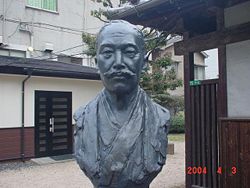Difference between revisions of "Mori Ogai" - New World Encyclopedia
Keisuke Noda (talk | contribs) (imported from wiki) |
m ({{Contracted}}) |
||
| Line 1: | Line 1: | ||
| − | + | {{Contracted}} | |
[[Image:Mori Ogai statue in Tsuwano.jpg|thumb|right|250px|Mori Ogai's statue at his birthhouse in [[Tsuwano-cho]]]] | [[Image:Mori Ogai statue in Tsuwano.jpg|thumb|right|250px|Mori Ogai's statue at his birthhouse in [[Tsuwano-cho]]]] | ||
Revision as of 21:26, 27 September 2006
Mori Ogai (森 鷗外 / 森 鴎外 Mori Ōgai, February 17, 1862 - July 8, 1922) was a Japanese physician, translator, novelist and poet. He was born in Tsuwano, Iwami province (now Shimane prefecture) into a family of doctors. Gan (1911–13, Wild Geese) is considered as his major work.
Career
Mori was sent to study in Germany (Leipzig, Dresden, Munich, and Berlin) by the Meiji government in 1884 where he stayed for four years. Upon his return he assumed a high rank as a medical doctor in the Japanese army. As a physician, Mori specialized in beriberi, an ailment caused by a deficiency of thiamine. He wrongly believed that beriberi was an infectious disease and refused to implement the dietary policy which was adopted by the Japanese Navy and which demonstrably cured the ailment for 99% of patients. His questionable decisions during the Russo-Japanese War caused the deaths of ten of thousands of Japanese soldiers to beriberi. In 1907, Mori became Surgeon-General, and in 1916 he was appointed director of the Imperial Museum.
It was during the Russo-Japanese War (1904-5) that Mori started keeping a poetic diary. After the war, he began holding tanka writing parties that included several noted poets such as Yosano Akiko. As an author, Mori is considered one of the leading writers of the Meiji period, known for works including Maihime (舞姫, The Dancing Girl, 1890), describing an affair between a Japanese man and a German woman, Sanshō Dayū (山椒大夫), and Takasebune (高瀬舟). He also produced translations of the works of Goethe, Schiller, Ibsen, Hans Christian Andersen, and Hauptmann, and instituted modern literary criticism in Japan, based on the aesthetic theories of Karl von Hartmann. Most of his later work is biographical or historical.
Ōgai's most popular novel, Gan (1911–13; The Wild Geese), is set to 1881 Tokyo and was filmed by Shiro Toyoda in 1953 as The Mistress.
Mori's real name was Rintarō (林太郎). Ōgai is correctly written 鷗外 but many computers cannot properly display this kanji and so 鴎外 is often used in its place.
A house which Mori lived in is preserved in Kokura Kita ward in Kitakyushu, not far from Kokura station. Here he wrote Kokura Nikki (Kokura diary). His birthhouse is also preserved in Tsuwano. The two one-story houses are remarkably similar in size and in their traditional Japanese style.
One of Mori's daughters, Mori Mari, influenced the Yaoi movement in contemporary Japanese literature.
Selected works
- Maihime (1890, 舞姫, The Dancing Girl)
- Utakata no ki (1890, Foam on the Waves)
- Fumizukai (1891, The Courier)
- Ita sekusuarisu (1909, Vita Sexualis)
- Seinen (1910)
- Gan (1911–13, The Wild Geese)
- Okitsu Yagoemon no isho (1912, The Last Testament of Okitsu Yagoemon)
- Sanshō Dayū (1915, 山椒大夫, Sanshō the Steward)
- Shibue Chūsai (1916)
- Takasebune (1916, 高瀬舟, The Boat on the Takase River)
Translations
- The Historical Fiction of Mori Ôgai, ed. David A. Dilworth and J. Thomas Rimer. 1977. Honolulu: University of Hawaii Press, 1991. A one-volume paperback edition of an earlier two-volume collection of stories.
- Modern Japanese Stories: An Anthology, ed. Ivan Morris. 1961. Rutland, Vt.: Charles E. Tuttle, 1966. Contains "Under Reconstruction."
- Sansho-Dayu and Other Short Stories, trans. Tsutomu Fukuda. Tokyo: Hokuseido Press, 1970.
- Vita Sexualis, trans. Kazuji Ninomiya and Sanford Goldstein. 1972. Boston: Tuttle Publishing, 200.
- The Wild Geese, trans. Ochiai Kingo and Sanford Goldstein. Boston: Tuttle Publishing, 1959.
- The Wild Goose, trans. Burton Watson. 1995. Ann Arbor: University of Michigan Center for Japanese Studies, 1998.
- Youth and Other Stories (collection of stories), ed. J. Thomas Rimer. 1994. Honolulu: University of Hawaii Press, 1995
Source
See also
- Kokura
External links
- e-texts of Mori Ōgai 's works at Aozora bunko
de:Mori Ōgai fr:Ōgai Mori it:Ōgai Mori ja:森鴎外
Credits
New World Encyclopedia writers and editors rewrote and completed the Wikipedia article in accordance with New World Encyclopedia standards. This article abides by terms of the Creative Commons CC-by-sa 3.0 License (CC-by-sa), which may be used and disseminated with proper attribution. Credit is due under the terms of this license that can reference both the New World Encyclopedia contributors and the selfless volunteer contributors of the Wikimedia Foundation. To cite this article click here for a list of acceptable citing formats.The history of earlier contributions by wikipedians is accessible to researchers here:
The history of this article since it was imported to New World Encyclopedia:
Note: Some restrictions may apply to use of individual images which are separately licensed.


